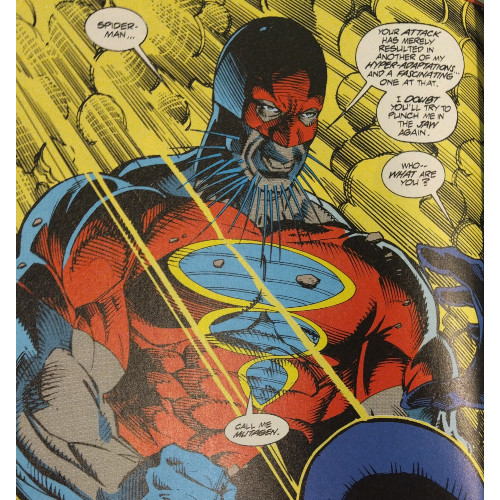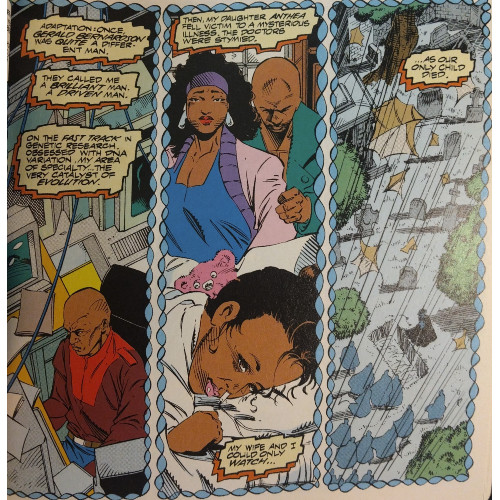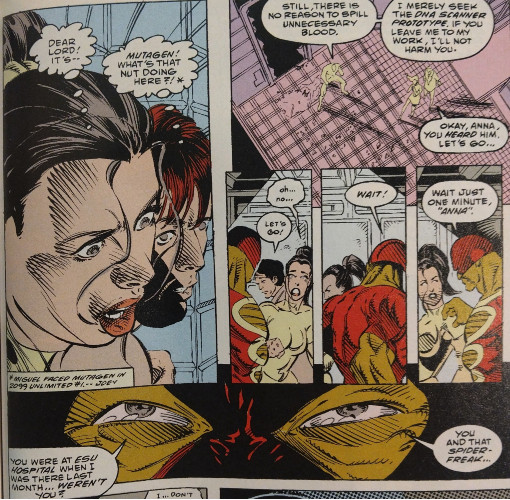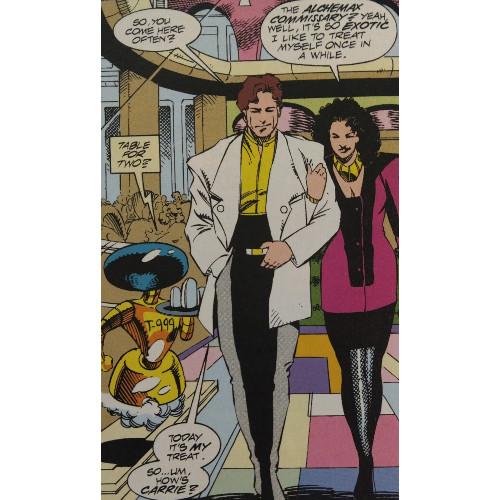Spider-view: "Nothing Ever Changes" (Spider-Man 2099, Part 5)
A new villain is given greater weight conceptually than practically, ideas outweighing execution and exposition
—by Nathan on September 20, 2025—

For the second "Spider-view" post in a row, we are exploring the world of 2099 and the Spider-Man who swings there. Just like our sci-fi Spidey isn't named "Peter," neither is our writer this time around. Another man has taken the webs for this narrative, featured in the first and third issues of a spin-off title, 2099 Unlimited.
Cause if something works well, the easy thing to do is make more of it. The tactic's worked with our main Spider-Man, Peter Parker launching into multiple spin-offs (including his own Unlimited title which kicked off the "Maximum Carnage" saga), so maybe it'd work with the Miguel O'Hara version.
2099 Unlimited is a title shared between Miguel and Hulk 2099, a green monster inspired by the Bruce Banner version, debuting this issue. The Hulk halves of these issues have not, to my knowledge, been collected, or at least don't appear in the trade paperbacks I own, so we are not focusing on the giant green rage monster of the future. We're here for swinging Spidey action, anyway.
And Spidey does swing in these issues, but he's not the only one possessing a unique system of animal-inspired locomotion in this narrative, as we will see.
"Nothing Ever Changes"/"Spare Changes"
Writer: Evan Skolnick
Penciler: Chris Wozniak
Inker: Christopher Ivy
Colorist: Marie Severin
Letterers: Steve Outro, Rod Olleranshaw
Issue: 2099 Unlimited #1, #3
Publication Date: July 1993, January 1994

As the second Unlimited issue, published three months after the first issue, tells a completely different, standalone story from this one, I am saving it for a different post. This two-parter, the second half published half a year after the first, tells its own, kinda complete story.
"Kinda," because there is an indication that this issue was not intended to be the last featuring villain Mutagen, a former genetic researcher obsessed with evolution who tampered with his own DNA. He became capable of altering his body to counter any attack or obstacle in his way, not too dissimilar to X-Men member Darwin. Unlike Darwin's film version, Mutagen doesn't go out like an absolute punk in this tale. Like with Darwin, however, I can't necessarily call Mutagen's own narrative "satisfying."

I'll give Skolnick and Wozniak credit for the concept–Mutagen predates Darwin by over a decade, so the idea of a character whose body changes to counter danger is interesting. Mutagen's micro-evolutions are all animal in nature–wings to save him from falling, bone plating to make him resistant to impacts, fur to protect him from freezing–and I can see where the creators would have had a fun opportunity in developing different looks and defenses for the villain. They toy with Mutagen's appearance constantly and in a way which seems logical in two different encounters with Spider-Man. The character's central motivation, cleansing the gene pool of aberrations, is also terrifying. Here is a man willing to kill anyone he subjectively determines is genetically unfit to continue living–he's not even the Punisher, killing actual criminals. He kills indiscriminately, but that definition is based purely on his whims. It's a terrifying thought.
His backstory–a scientist who lost a loved one to an inherited genetic anomaly and seeks to cleanse the gene pool to prevent further tampering in future generations–is interesting, to a point. We get a good chunk of exposition outlining his background, and though Wozniak, with some coloring help from industry legend Marie Severin, constructs the sequence in an engaging way, the narrative drags a little here. The scene looks great–three pages parallel one another, with top panels in the present juxtaposed with bottom panels as flashbacks. Wozniak develops some realistic-looking animals, and the flashback scenes are surrounded by strands of DNA, creating clever images. But the narrative itself is cliche, highly reminiscent of another vigilante involved in the sciences whose lost loved one prompted him to turn to less-than-legal activities…oh, and Cardiac has fought somebody named "Spider-Man," too. So Mutagen, though artistically engaging, is not the most narratively interesting character.

Maybe this is why his own narrative sags a little bit across the issues, coming across somewhat generic despite the clever concept propelling him forward. He battles Spidey at two different locations and, funnily enough, interacts with the same supporting cast member, a female coworker/friend of Miguel's named Anna. Coincidence? Absolutely, but I didn't feel overly frustrated with it, as I have with some other stories. It just means Miguel saves the same damsel in distress from the menace of Mutagen.
What's more frustrating is that Mutagen's own story ends on a cliffhanger of sorts, a promise of a return which never actually happens. According to a Marvel database I frequent, Mutagen has never appeared outside of these two issues, so though the cliffhanger generates some interest–I won't spoil it, but let's say our villain isn't as soundly defeated as everyone thinks he is–the fact that it was left unfinished is a bummer. Mutagen isn't a brilliant character, and you can easily slot him in the same category as characters such as Cardiac, Annex, or the Cadre–a proliferation of armored or violent vigilantes, spawned from potentially interesting concepts, but falling victim to the excesses of the 90s and finding themselves irrelevant after a handful of appearances. Still, given the story ends feeling unfinished, I was hopeful for at least a final chapter to wrap up this dangling thread.

Elsewhere, I found Skolnick played a little fast and loose with Miguel's character, particularly in his relationship with coworker/friend Anna. David has shown us that Miguel is engaged to Donna, and though she herself has a past with Miguel's brother Gabe (even kissing him in one issue), no other narratives have indicated any disruption in their relationship. Miguel's conduct around Anna, however, is surprisingly flirtatious, taking her to lunch, holding her arm, and spouting witty, playful banter. Again, this isn't a side of Miguel David has indicated exists, so it feels a little off-putting, as if Skolnick hasn't quite done his homework on the character.
Where the story and characters sag, the art excels, and not just with the Mutagen character. Wozniak takes a page from Rick Leonardi's book and peppers the world of 2099 with engaging details, from drivers in hover cars looking for a parking space, to a robot waiter, to robotic window washers. Small details, effectively used, giving a lived-in sense to this future world. A scene opening the third issue involving a high-speed hover car pursuit capably translates the kind of small-time criminals and action Peter Parker would find in his present time to the future, giving the familiar an updated face.

This is one of those stories where the narrative told is outweighed by the art. Creating comics is a collaborative effort, so I don't want to sound like I'm short changing Skolnick by giving Wozniak all the creative credit. I don't know what the collaborative process was between them in developing Mutagen or picturing the world surrounding our characters. What I am saying is it ends up looking better than it reads, and if Skolnick contributed to more of the story outside the dialogue, than I applaud his efforts with Wozniak. But on the surface, the art makes this two-issue tale stand out more than story, showing that Wozniak apes his central villain in adapting his designs to work with the strengths of Marie Severin and inker Christopher Ivy to accentuate the narrative.